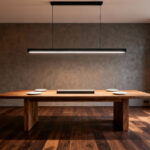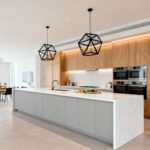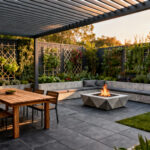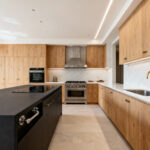You know what people always ask me? It’s not just about their desk setup or their Zoom background. Sooner or later, the conversation turns to how their whole home environment impacts their focus. And it always starts with the same place: the bathroom. That’s the room where your day begins and ends. It’s your personal launchpad. If it’s chaotic and stressful, you’re starting your workday already behind.
That’s why I’m a huge advocate for the coastal bathroom concept, but not in the way you see on Pinterest with a thousand seashells glued to a mirror. For me, “coastal” is a design strategy. It’s about creating a space that’s calm, bright, organized, and restorative. It’s about building a personal sanctuary that helps you reset, recharge, and gear up for a productive day. It’s not about trends; it’s about engineering a better start to your morning.
So let’s break it down, no corporate-speak. Here’s how to create a bathroom that works as hard for your well-being as you do at your job.
Foundations: Setting Your Coastal Vision and Palette
This is the bedrock. Get this wrong, and you’re just throwing sand and starfish at the wall. This is where we make the big, simple decisions that will make every other choice easy. It’s about creating a clear framework so you don’t get lost in the weeds later.
1. Discovering Your Ideal Coastal Color Palette for Serenity
Can we just talk about why everyone gets color wrong? They pick something that looks good on a tiny paint chip under the horrible fluorescent lights of the hardware store. Then they get it home and wonder why their “serene seafoam” bathroom feels like the inside of a hospital. Here’s the deal: color isn’t just about looks, it’s about cognitive load. Your brain has to process it, and first thing in the morning, the last thing you need is a visual puzzle.

What actually matters is creating a palette that feels restful. Think about the colors of a slightly overcast day at the beach: soft whites, sandy beiges, muted blues, and foggy grays. These colors don’t scream for attention. They’re a quiet backdrop that lets your mind ease into the day. The noise is all the super-saturated, high-contrast “tropical” palettes. Save the vibrant coral for a throw pillow somewhere else. Here, we want calm. My shortcut is the 60-30-10 rule: 60% is your main neutral (like a soft off-white), 30% is a secondary, slightly deeper neutral (like a warm gray or pale blue), and 10% is your accent—think weathered wood or a hint of brushed brass. It’s foolproof.
With the color set, the next non-negotiable is light. It’s the engine that makes the whole coastal vibe run.
2. Maximizing natural light for a Brighter, Airier Feel
Everyone says you need natural light, but they don’t tell you why it’s so critical for your productivity. It’s not just about saving on your electric bill. Natural light is what syncs your internal clock—your circadian rhythm. A blast of bright, natural light in the morning tells your brain, “It’s go-time.” It wakes you up better than coffee. A dark, gloomy bathroom does the opposite. It tells your body it’s still nighttime, making it harder to get moving and focus.

So how do you actually get more of it? If you have a window, don’t you dare cover it with heavy blinds. Go for a sheer linen curtain or a top-down/bottom-up shade that gives you privacy without blocking the sky. If you’re windowless, this is where the magic happens. A large, simple, frameless mirror will bounce whatever light you do have around the room, faking it. Pair that with light-colored, slightly glossy tiles. I had a client in a city apartment with a tiny, dark internal bathroom. We put a massive mirror on one wall and used high-gloss white subway tile. It felt twice as big and ten times as bright, instantly changing how she felt getting ready for work each morning.
Now that we’ve got light and color, you have to pick a lane. Don’t try to be everything at once.
3. Choosing Between Nautical Charm and Beach House Simplicity
You know what kills a good design? Indecision. People try to do “coastal,” so they grab a striped navy towel, a piece of driftwood, and a modern teak stool. It ends up looking like a confused mess. You have to choose: are you going for crisp, classic Nautical Charm or relaxed, organic Beach House Simplicity? This isn’t just aesthetics; it’s about reducing your own decision fatigue.

Nautical is about structure: navy, white, brass, crisp lines. Think of a captain’s quarters on a sailboat. Beach House is about flow: soft whites, weathered woods, woven textures, and organic shapes. Think of a barefoot walk on the sand. Pick one. Stick to it. This becomes your filter for every other decision, from the faucet to the soap dish. It’s the shortcut you need. I once worked with an entrepreneur who was totally paralyzed by his bathroom reno. We spent 10 minutes making a “Beach House” vision board. Suddenly, everything was clear. No more “what-ifs.” It saved him weeks of agonizing.
Once you know your style, you have to make sure it lasts. Nothing drains your energy like having to fix stuff all the time.
4. Selecting Durable, Water-Resistant Materials for Longevity
Let me tell you a secret about productivity: it’s not just about managing your time, it’s about eliminating future problems. Choosing the right materials for a bathroom is the ultimate productivity hack because you are literally designing less work for yourself later. Using materials that can’t handle humidity is like planning to have a leak. It’s a guaranteed time-suck and money pit waiting to happen. Mold, warped wood, peeling paint—these are problems that will drain your energy and your bank account.

So here’s what actually matters: porcelain tile. It’s basically bomb-proof. It doesn’t absorb water, it’s easy to clean, and it comes in a million “sand-toned” or “weathered wood” looks. For your vanity countertop, go with quartz. It’s non-porous and you don’t have to seal it like you do with marble or granite. The biggest BS in this area is contractors who say, “Oh, this wood is fine.” No. Unless it’s teak or properly sealed marine-grade wood, it’s not fine. The shortcut? If you’re ever in doubt, ask, “Would you put this on a boat?” If the answer is no, don’t put it in your bathroom.
This solid foundation of durability is what allows you to actually relax and turn the space into a real retreat.
5. Creating a Calming, Spa-Like Coastal Bathroom Retreat
The term “spa-like” gets thrown around a lot. What does it actually mean? It means creating a space that calms your nervous system on a sensory level. This is absolutely critical for remote workers, because the line between “work” and “life” is so blurry. Your bathroom needs to be a dedicated “off” switch. It’s a place where you can mentally reset before diving into your inbox or decompress after a long day of video calls.

To do this, think beyond the visuals. What does it feel like? Get a plush bath mat that feels good on your feet. What does it smell like? Use an essential oil diffuser with a subtle scent like eucalyptus or cedarwood. What does it sound like? Install a quiet exhaust fan, not one that sounds like a jet engine. My biggest pet peeve is people spending a fortune on a gorgeous bathroom and then leaving a plastic bottle of neon-green soap on the counter. Decant your soap, shampoo, and conditioner into simple, matching pump bottles. It’s a five-minute task that eliminates daily visual clutter and instantly makes the space feel intentional and serene.
Now, let’s talk about the specific architectural pieces that build this feeling.
Structural Elements: Essential Materials and Fixtures
These are the bones of the room. The fixtures and wall treatments that you’ll live with for years. Getting these right means you create a timeless look that supports your daily routine instead of getting in the way.
6. Installing Classic Shiplap or Beadboard for Authentic Charm
Okay, let’s be honest. Most bathroom walls are just boring, flat drywall. Shiplap or beadboard is the fastest way to add texture and architectural character without having to hire a master carpenter. It immediately gives the space a sense of history and craftsmanship that feels comforting and established, which is the whole point of the coastal vibe. It breaks up the monotony of flat surfaces and gives your eyes something interesting, yet calming, to look at.

But here’s the pro move: don’t use real wood. Everyone thinks they want authentic wood shiplap until it warps from the humidity or they have to repaint it every two years. The shortcut is to use PVC or AZEK beadboard panels. It looks identical, it’s 100% waterproof, it will never rot or mold, and you can clean it with anything. A client of mine installed real wood beadboard as wainscoting, and a year later the seams were gapping and there was mildew in the grooves. We ripped it out and replaced it with PVC. It looks better and he’ll never have to touch it again.
Once your walls have character, you need the right hardware to complete the look and stand up to the environment.
7. Opting for Marine-Grade Hardware and Finishes That Endure
Nothing kills a calm, high-end vibe faster than rusty or pitted hardware. A little spot of orange on your faucet or towel bar is a constant visual reminder of decay. It’s a tiny bit of negative feedback you get every single day. The BS everyone tells you is that “brushed nickel” or “chrome” is all you need. In a humid bathroom, especially in a coastal climate, that’s not enough.

You need to think like a boat builder. The key phrase is “PVD finish” (Physical Vapor Deposition). It’s a special coating process that makes finishes incredibly durable and resistant to corrosion and tarnish. Or look for “316 Stainless Steel,” which is true marine-grade. I learned this the hard way on one of my first design projects. We used standard, high-quality chrome fixtures in a beach house. They looked amazing for about six months. Then, little rust spots started showing up everywhere. We had to replace everything. Now, I tell my clients: spend the extra 20% on PVD or marine-grade hardware. It’s an investment in not having to deal with this problem ever again.
Hardware sets the tone. But the vanity is the functional heart of the bathroom.
8. Choosing Coastal-Inspired Vanities and Sinks That Define Style
Your vanity is the single most important piece of furniture in the room. It’s not just a box to hold a sink. It has a job to do: store all your stuff so it’s not cluttering up the countertops. A cluttered counter is visual noise. It’s a to-do list you see first thing in the morning, and it causes low-grade stress before you’ve even had coffee. The “open-shelf” vanity trend is a trap for most people. It looks great in magazines where there are three artfully rolled towels and a single seashell, but in real life, it’s a magnet for junk.

So, the rule is drawers over doors. Drawers are infinitely more efficient for organizing small bathroom items than a big, cavernous cabinet where everything gets lost in the back. A vanity with deep, functional drawers allows you to hide everything away, keeping your surfaces clear and your mind clear. For the style, look for vanities with simple lines, maybe with a shiplap detail or in a light wood tone like white oak. I had a client, a busy executive, whose bathroom counter was a disaster zone of products. We switched his open vanity for one with three deep drawers. He said it was life-changing. His morning routine was faster and less stressful because everything had a home.
To balance the hard surfaces of tile and a vanity, you need to bring in some natural, organic textures.
9. Integrating Natural Wood or Rattan for Organic Warmth
A bathroom can easily feel cold and clinical with all that tile and porcelain. Natural materials like wood and rattan are the antidote. They bring in warmth, texture, and a connection to nature—which is a proven stress reducer. This is called biophilic design, and it’s not just some woo-woo concept. Seeing and touching natural materials has a grounding, calming effect on our brains. It’s an essential ingredient for making a space feel like a sanctuary, not just a utility room.

The trick is to use these materials in smart, contained ways. The noise is when people try to do a whole reclaimed-wood wall in a shower. That’s a maintenance nightmare. Instead, focus on accents. A simple teak stool next to the tub. A set of woven rattan baskets on a shelf to hold towels. A mirror framed in weathered wood. I once convinced a client to swap his metal trash can for a simple, lidded wicker basket. It’s a tiny change, but it softened the whole corner of the room and made it feel more deliberate and less sterile. That’s the shortcut: small, impactful touches of nature.
Finally, for the structural elements, let’s talk about what’s under your feet.
10. Selecting Non-Slip, Sand-Toned Floor Tiles for Safety and Style
I have a pet peeve. It’s those super-glossy, polished floor tiles you see in high-end design magazines. They look incredible until you add one drop of water, at which point they become a death trap. You cannot relax in a space where you are subconsciously worried about slipping and cracking your head open. Safety is the foundation of comfort. It’s non-negotiable.

So what matters here is a tile with a good DCOF rating (Dynamic Coefficient of Friction). You want something rated 0.42 or higher for wet areas. This usually means a tile with a matte or slightly textured finish. Luckily, this plays perfectly into the coastal theme. There are countless amazing porcelain tiles that look and feel like sand or natural stone. They hide water spots and footprints, and they provide the grip you need to actually use the space without fear. I always tell my clients to get a sample, take it home, pour a little water on it, and see how it feels. Don’t trust the label, trust your feet.
With the heavy lifting done, we can now focus on the elements that bring the personality and ambiance.
Ambiance & Details: Elevating with Decor and Lighting
This is the fun part. The structural work is the stage, but the decor and lighting are the performance. This is where you layer in personality and mood to transform the room from a well-designed box into a space that feels uniquely yours.
11. Adorning with Thoughtful Ocean-Inspired Decor Elements
Here’s where it all goes wrong for most people. They hear “coastal” and run to the home goods store and buy a bunch of mass-produced, glittery starfish and signs that say “BEACH.” This is the fastest way to make your sophisticated retreat look cheap and tacky. Stop it. A curated space is about quality, not quantity. The clutter of a dozen cheap knick-knacks is just as bad for your brain as a cluttered countertop.

The real key is to focus on texture and form, not literal representations. Think one large, sculptural piece of driftwood, not a bowl of tiny ones. A single, perfect conch shell on a shelf. A beautiful piece of abstract art with blues and greens. I had a client who loved the beach, so we found one huge, beautiful photo of an empty stretch of coastline at sunrise, framed it simply, and made it the only piece of art in the room. It was personal, powerful, and a hundred times more effective than a gallery wall of generic beach signs. Less is more.
That art and decor won’t pop unless the lighting is right.
12. Enhancing Your Coastal Ambiance with Strategic Lighting
If you only listen to one piece of advice in this whole article, make it this: put everything on a dimmer. Everything. There is no single bigger bang-for-your-buck upgrade you can make to a space. Your lighting needs change throughout the day. You need bright, clear light for putting on makeup or shaving in the morning. But at night, when you’re winding down, that same bright light is jarring and can mess with your sleep. Dim, warm light in the evening signals to your brain that it’s time to relax.

The professional approach is called “layering light.” You need three types. Ambient light: general overhead light, like recessed cans. Task light: focused light where you need it, like sconces on either side of your mirror (never a single fixture above the mirror—it creates horrible shadows). And accent light: a small, decorative light, like a pendant over a tub, to create mood. I had a client install a system where one switch set a “morning scene” (bright task and ambient) and another set an “evening scene” (dim accent and ambient). It completely changed how they used the room. It became a functional prep space and a restorative escape.
Light is half the battle when creating an illusion of space. Mirrors are the other half.
13. Using Mirrors to Visually Expand Small Bathroom Spaces
Everyone knows mirrors make a room feel bigger. But they often use them wrong, picking a dinky little mirror that’s too small for the vanity, which just looks awkward. The rule is to go as big as you can. A large, wall-to-wall mirror over the vanity, or even a full mirrored wall, can visually double the size of the room. This isn’t just a design trick; it has a psychological effect. It makes a small, potentially claustrophobic space feel open and airy, which reduces feelings of stress and confinement.

I once worked on a tiny powder room in a city townhouse. It was basically a closet. We put a floor-to-ceiling mirror on the entire wall behind the toilet and sink. It instantly felt enormous and dramatic. The other key is placement. If you can, put the mirror opposite a window to bounce all that precious natural light around. And don’t overdo the frame. A simple, thin metal frame or a frameless design keeps the look clean and maximizes the reflective surface.
Mirrors add a hard, reflective surface. Now let’s soften things up.
14. Choosing Soft, Absorbent Towels in Complementary Coastal Hues
Towels aren’t just for drying off. They are a huge part of the tactile experience of your bathroom, and they’re one of the easiest ways to inject color and texture. Buying cheap, scratchy towels is a terrible investment in your own daily comfort. Every time you use them, you’re getting a little bit of negative sensory feedback. Investing in good towels is a small luxury that pays off every single day.

What you’re looking for is a high GSM (grams per square meter) — anything from 600-900 is going to feel plush and absorbent. Turkish or Egyptian cotton is the gold standard. For colors, stick to your chosen palette. A stack of fluffy white towels is timeless. Or pull one of the subtle blues or sandy beiges from your palette. A confession: for years, I had a mismatched collection of towels from college. The first time I bought a full set of new, high-quality towels in a single color, it felt like I had finally become a real adult. It’s such a simple upgrade that makes a huge difference.
And for one last touch of softness and life…
15. Bringing Life with Low-Maintenance, Air-Purifying Bathroom Plants
A bathroom is the perfect environment for certain plants. They love the humidity, and in return, they add a touch of life, purify the air, and contribute to that biophilic, connected-to-nature feeling we’re after. A little bit of green makes a space feel healthier and more vibrant. It’s a simple way to make your bathroom feel less like a sterile box and more like a living part of your home.

But please, don’t get a fiddle-leaf fig or some other drama-queen plant that will die if you look at it wrong. You want something low-maintenance that thrives on neglect. The holy trinity of bathroom plants is the Snake Plant, the ZZ Plant, and the Pothos. They tolerate low light, love humidity, and can survive if you forget to water them for a few weeks. A simple Pothos with its vines trailing down from a high shelf can transform a corner of your bathroom and requires almost zero effort. It’s the ultimate ROI for a living decor piece.
Now, let’s talk about the final, personal touches that make the space truly yours.
Personalization & Preservation: Unique Touches and Upkeep
A well-designed space is great. But a space that tells your story is even better. This is about adding meaningful layers and then, crucially, knowing how to take care of them so your sanctuary stays serene for years to come.
16. Curating a Unique Collection of Seashells and Beach Glass
Remember when I said to avoid the gift shop knick-knacks? This is the exception, with a big condition: the items have to be yours. A bowl of shells you bought in a bag has no soul. But a small, curated collection of stones and beach glass you and your family collected on a favorite vacation? That’s not decor, that’s a story. Those objects have personal meaning and will give you a tiny hit of joy and nostalgia every time you see them.

The key is “curated.” Don’t just dump them on a shelf. Arrange them thoughtfully in a beautiful glass jar, a shadow box, or a simple ceramic bowl. Pick the best ones. Edit mercilessly. It’s about creating a small, intentional moment of beauty that is unique to you. The BS is thinking you need to fill every surface. You don’t. One thoughtful collection is more powerful than a hundred random objects.
To take that idea a step further, look beyond the beach itself.
17. Incorporating Upcycled Maritime Objects for Distinct Character
This is advanced-level personalization. Finding a genuine, salvaged maritime object and giving it a new life in your bathroom adds a layer of history and authenticity that you can’t buy new. It creates an instant focal point and conversation starter. We’re talking about an old ship’s porthole turned into a mirror, a boat cleat used as a towel hook, or a piece of salvaged ship’s timber used as a floating shelf.

But be careful. The danger here is tipping into theme-park territory. The rule is one. Pick one awesome statement piece and let it be the star. Don’t have a porthole mirror and a ship’s wheel on the wall and a buoy lamp. That’s too much. I saw a bathroom once where the designer used a beautiful, weathered old wooden oar mounted vertically in a corner as a piece of sculpture. It was simple, unexpected, and brilliant. It told a story without screaming “NAUTICAL THEME.”
Finally, after all this work, you have to protect your investment.
18. Maintaining the Freshness and Longevity of Your Coastal Haven
You’ve built your sanctuary. Now you have to keep it that way. A beautiful bathroom that’s covered in soap scum or has the beginnings of mildew in the grout is not a sanctuary. It’s just another job on your to-do list. Proactive maintenance is the key to preserving that feeling of fresh, calm escape. Your future self will thank you.

Here’s the shortcut: buy a good squeegee and keep it in the shower. A 30-second wipe-down of the glass and tile after every shower prevents 90% of all soap scum and water spot buildup. And for the love of God, run your exhaust fan. Not just during your shower, but for a good 20-30 minutes after. Humidity is the enemy. It’s what causes mold, peels paint, and warps wood. I recommend upgrading your fan switch to one with a timer so you can just hit it and forget it. A simple routine is the difference between a haven that lasts and a renovation that looks old in two years.
Conclusion
So there it is. Designing a coastal bathroom isn’t about creating a movie set. It’s a practical strategy for building a pocket of serenity in your home that supports your life and work. By focusing on a calm palette, maximizing light, choosing durable materials, and layering in thoughtful, personal details, you’re not just renovating a room. You’re investing in your own well-being. You’re engineering a space that helps you start your day with clarity and end it with calm.
That’s the real power of good design. It’s not just about how it looks; it’s about how it makes you feel and how it helps you function. Dive in and build the oasis you deserve. You’ve earned it.






